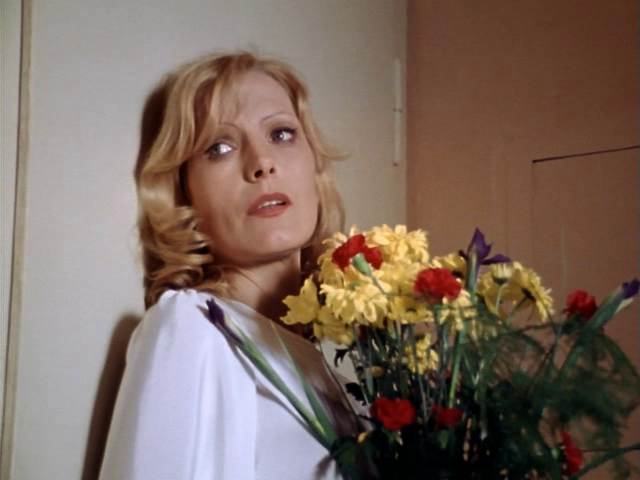The Great Acting Blog: “The Acting In Fassbinder’s Fear Of Fear”
27.12.2012
, The Great Acting Blog

Margit Carstensen in Fassbinder’s Fear Of Fear.
Fassbinder’s Fear Of Fear is a quite brilliant tale about Margot, whose harmonious family life with husband Kurt and daughter Bibi, unravels as she begins to suffer from anxiety attacks leading to alcoholism, an illicit affair, and a spell in a mental hospital. Margit Carstensen’s performance as Margot is sensational, and marked as it is by a spectacular emotional acuity. However, one of the really striking aspects about this film is the general excellence of all the performances; from Irm Hermann and Brigitte Mira as Carstensen’s nagging in-laws, to Adrian Hoven’s seduce-and-destroy Doctor Merck, to all the performances in between, each possesses a precision and intensity.
I wondered how these performances were arrived at, and so had a little nose around the internet, but could find precious little about Fassbinder’s thoughts on the subject. However, I did find this comment he made about working on Berlin Alexanderplatz, which may help to explain his general conceptions about acting: –
“I find it awful when a person in a film talks the way people talk in real life. In my opinion that robs a thought of its general force. It eliminates the general state of fearfulness. How should I put it? It reduces everything to something the moviegoer can reject, simply because he doesn’t happen to speak this dialect, doesn’t move this particular way in real life. In my opinion artificiality offers the only possibility for giving a broad spectrum of moviegoers access to the specific world of an artistic work”.
It’s hard to know what process Fassbinder and his actors went through, but due to their predominantly theatrical background, one would assume that there would have been a decent rehearsal period, which means that there was an opportunity to shape the performances, fitting them into Fassbinder’s overall vision for the film. Furthermore, Fassbinder wrote the script himself, and so would have created the structure he wanted the performances to slot into. This all helps to create the uniformity of style which the actor’s performances possess. This, coupled with the considerable talents of the actors Fassbinder employed, would help to explain the general level of excellence. But what of the style? I would describe the acting in Fear Of Fear as distilled; there is a clarity of idea and action in each scene, which leads to very precise intentions, everything we see the actors do is deliberate, and therefore meaningful. Fassbinder blocks the actors very carefully, almost to the point of choreography. This all adds up to the “artificiality” Fassbinder mentions – we are witnessing performances rather than snap-shots of life. This artificiality is characteristic of “the specific world of an artistic work”, or, put another way, artificiality renders a work artistic.
RELATED


Wiadomości/ 21.04.2022
Many people say that the Internet is full of junk, but awesome websites like this prove that quality still exist.
redditsave/ 05.05.2023
… [Trackback]
[…] Find More on on that Topic: jamesdevereaux.com/the-great-acting-blog-the-acting-in-fassbinde/ […]
ยูเรเนียน/ 10.06.2023
… [Trackback]
[…] Info on that Topic: jamesdevereaux.com/the-great-acting-blog-the-acting-in-fassbinde/ […]
영화 다시보기/ 19.06.2023
… [Trackback]
[…] Info on that Topic: jamesdevereaux.com/the-great-acting-blog-the-acting-in-fassbinde/ […]
Online medicatie kopen zonder recept bij het beste Benu apotheek alternatief in Amsterdam Rotterdam Utrecht Den Haag Eindhoven Groningen Tilburg Almere Breda Nijmegen Noord-Holland Zuid-Holland Noord-Brabant Limburg Zeeland Online medicatie kopen zonder recept bij beste Benu apotheek alternatief/ 09.10.2023
… [Trackback]
[…] Here you can find 71101 more Info on that Topic: jamesdevereaux.com/the-great-acting-blog-the-acting-in-fassbinde/ […]
รับติดตั้งโซล่าเซลล์/ 12.10.2023
… [Trackback]
[…] Read More on that Topic: jamesdevereaux.com/the-great-acting-blog-the-acting-in-fassbinde/ […]
clase azul bottle ideas/ 24.10.2023
… [Trackback]
[…] Info to that Topic: jamesdevereaux.com/the-great-acting-blog-the-acting-in-fassbinde/ […]
slotjili/ 03.11.2023
… [Trackback]
[…] Find More here on that Topic: jamesdevereaux.com/the-great-acting-blog-the-acting-in-fassbinde/ […]
u31 com/ 03.12.2023
… [Trackback]
[…] Read More on that Topic: jamesdevereaux.com/the-great-acting-blog-the-acting-in-fassbinde/ […]
ติดเน็ตบ้าน AIS/ 12.01.2024
… [Trackback]
[…] Find More here to that Topic: jamesdevereaux.com/the-great-acting-blog-the-acting-in-fassbinde/ […]
aksara178/ 18.01.2024
… [Trackback]
[…] Read More here on that Topic: jamesdevereaux.com/the-great-acting-blog-the-acting-in-fassbinde/ […]
torqeedo electric motor|achiles boat|achillies inflatable boat|yamaha vmax 2021|avon boats|achilies boats|achillies inflatable boats|200 hp merc outboard|avon inflatable boats|avon boat|avon inflatable boat|honda boats|200hp mercury outboard|achillies inflatable boat|avon inflatables|200 hp mercsury outboard|yamaha 250 hp outboard|outboard jet motors for sale|4hp yamaha outboard|best 25 hp outboard|jet outboard motors for sale|yamaha extended warranty|yamaha 300hp outboard|used outboard jet motors for sale|70 hp outboard|2.5 hp mercury outboard|250hp outboard|mercury 30 horsepower outboard|outboard dealer|yamaha 4 hp outboard|25hp mercury|tohatsu 6hp|mercury 200 outboard|yamaha jet outboard|2.5 mercury outboard|yamaha 300 hp outboard|honda outboard engines|70 hp boat motor|inmar boats|merc 25 hp outboard|tohatsu 60hp|inmar boat|9.9hp mercury outboard|mercury 25 hp outboards|jet outboard motor|inflatable zodiac boats for sale|propane outboard|25 hp mercury outboard|honda outboard dealer near me|9.9 hp mercury/ 08.02.2024
… [Trackback]
[…] Read More on that Topic: jamesdevereaux.com/the-great-acting-blog-the-acting-in-fassbinde/ […]
buy uk drivers license online/ 28.02.2024
… [Trackback]
[…] Read More here on that Topic: jamesdevereaux.com/the-great-acting-blog-the-acting-in-fassbinde/ […]
hot wheels ultimate garage/ 11.03.2024
… [Trackback]
[…] Read More Info here to that Topic: jamesdevereaux.com/the-great-acting-blog-the-acting-in-fassbinde/ […]
auto swiper/ 25.03.2024
… [Trackback]
[…] Find More on on that Topic: jamesdevereaux.com/the-great-acting-blog-the-acting-in-fassbinde/ […]
links site/ 07.04.2024
… [Trackback]
[…] Read More on that Topic: jamesdevereaux.com/the-great-acting-blog-the-acting-in-fassbinde/ […]
slot terbaru/ 18.04.2024
Good day! This is my first visit to your blog! We are a collection of volunteers and starting a new project in a community in the same niche.
Your blog provided us valuable information to
work on. You have done a wonderful job!
welcome bonus/ 20.04.2024
You have made some decent points there. I checked on the net for more
info about the issue and found most people will go along with your
views on this website.